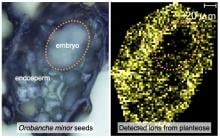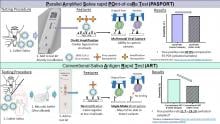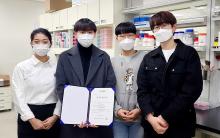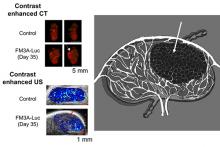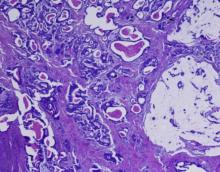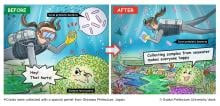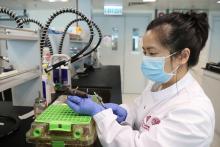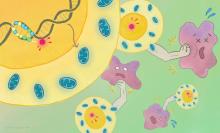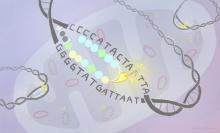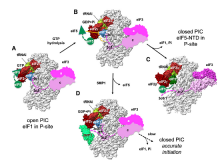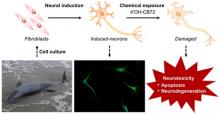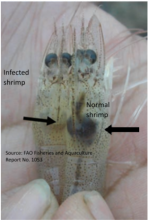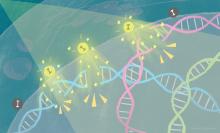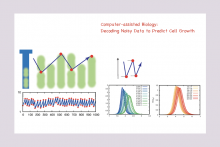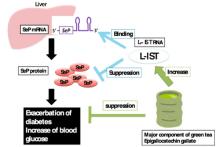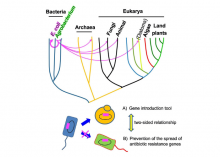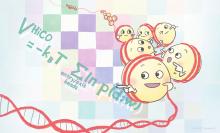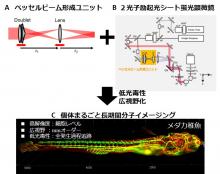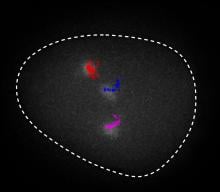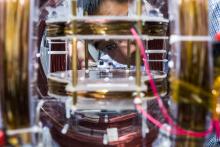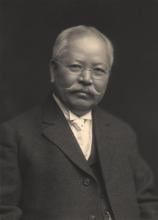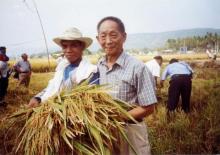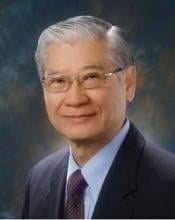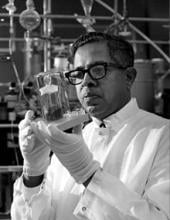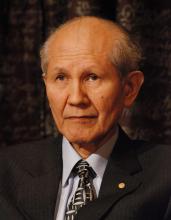Biotech
News
06 Jan 2022
Enzymatic hydrolysis of planteose: α-Galactosidase is a promising molecular target for root parasitic weed control
16 Dec 2021
Researchers are closer to understanding potential common features of sources of oxidative stress observed in several diseases, from Parkinson’s disease to cancer.
08 Dec 2021
A new saliva-based COVID-19 Antigen Rapid Test (ART) technology co-developed by the SingHealth Duke-NUS Academic Medical Centre and the National University of Singapore shows promise in early clinical testing, outperforming existing ARTs and delivering results in minutes, with nearly comparable sensitivity to the gold standard Polymerase Chain Reaction (PCR) test.
09 Nov 2021
Researchers from DGIST explore the role of symbiotic skin bacteria in wound healing for different fish species
02 Nov 2021
Cancer in the lymph nodes has the highest risk of spreading. To catch it early, doctors often employ CT scans, MRIs and Ultrasounds to look for blockages in the blood flow. Now, a research group better understands why this happens: tumors lacking blood vessels impair the blood flow.
02 Nov 2021
The world’s largest analysis of gastric tumour cells provides a launch pad for scientists to plan more effective therapies.
13 Oct 2021
Coral reefs, comprising some of the most diverse and delicate ecosystems under water, are under immense stress. From global warming to pollution to pathogens, many of the reef-building coral species are listed as threatened or endangered. But, according to researchers in Japan, the corals may have an unlikely ally: bacteria.
13 Oct 2021
Miniature brains mimic critical features of Parkinson's disease, better weather forecasting with satellite data, light does the twist for quantum computing, new insights into embryonic development & elevating women leaders in Myanmar in the October Editor's Choice. Plus don't forget submissions for Asia Research News 2022!
01 Oct 2021
Paris, 29 September — UNESCO and the L'Oréal Foundation are unveiling the winners of this year’s International Prize for Women in Science, which honours five eminent women scientists with exceptional careers from the five regions of the world, as it has done annually since 1998.
30 Sep 2021
Geb Impact aims to scale up microalgae production to provide novel super food ingredient by cost-effective mass cultivation of microalgae
28 Sep 2021
While the Covid-19 pandemic is ongoing, another public health threat, antibiotic resistance, continues unabated. Microbiologists and chemists from two universities in Hong Kong recently made a breakthrough in synthesizing the first vaccine against one of the most deadly antimicrobial resistant pathogens, Acinetobacter baumannii (A. baumannii). The vaccine shows good protection against the superbug in mice, indicating great potential as a vaccine for humans.

14 Sep 2021
Cochlear implants help deaf patients in hearing, yet the current technology remains far from perfect. A research team led by scientists from City University of Hong Kong (CityU) has shown that neonatally deafened rats could be trained with cochlear implant stimulation to restore the ability to locate the directions of sound origins. The finding implies that shortcomings in current cochlear implant technology, rather than the lack of auditory experience in early childhood, maybe the reason why cochlear implant patients usually have poor spatial hearing performance.
13 Sep 2021
iCeMS scientists and colleagues have designed a molecular code that powers up cancer-fighting immune cells.
10 Sep 2021
Magnetic patterns in meteorites, Treating mitochondrial diseases, underwater sensors and a broad COVID-19 vaccine in the September Editor's Choice. Plus, what's it like to communicate vaccine research in a pandemic and Asia Research News 2022.
07 Sep 2021
Giants in History: Gloria Lim (1930-11 July 2022) is a retired mycologist from Singapore who studied tropical fungi. One of the first students to attend University of Malaya when it was founded in 1949, she graduated as one of the two Botany Honours students from the inaugural class.
26 Aug 2021
A multi-functional, small molecule can tag mutant genetic sequences inside mitochondria for removal.
20 Aug 2021
A microphysiological system (MPS) is a 3D organ construct using human cells. They show us how organs respond to drugs and environmental stimuli. Now, Tohoku University researchers have developed a new imaging tool for MPS using scanning probe microscopy.
17 Aug 2021
Cells translate their genetic material at rapid rates with exquisite precision to reproduce, repair damage or even combat disease. But the process can deregulate and give rise to disease. Byproducts of errant processes can build up like gunk in the gears, especially around neurons, breaking down the repair mechanisms and causing further damage and even neurodegenerative disorders such as Alzheimer’s disease.
26 Jul 2021
Using neurons directly reprogrammed from tissues of stranded whales to assess brain health
A research team of the Center for Marine Environmental Studies (CMES) of Ehime University, Japan succeeded for the first time in direct reprogramming of whale somatic cells to neuronal cells, and conducted a neurotoxicity test using these cells. Exposure to a metabolite (4′OH-CB72) of polychlorinated biphenyls, ubiquitous environmental pollutants, caused apoptosis in the reprogrammed neurons. Transcriptome analysis of 4′OH-CB72-treated whale neurons showed altered expressions of genes associated with oxidative phosphorylation, chromatin degradation, axonal transport, and neurodegenerative diseases.
15 Jul 2021
Scientists at International Islamic University Malaysia have developed a probiotic-based treatment that could help Asia’s shrimp industry recover from repeated pandemics of bacterial infection.
14 Jul 2021
Researchers have found a way to enhance radiation therapy using novel iodine nanoparticles.
08 Jul 2021
Researchers at The University of Tokyo Institute of Industrial Science use artificial intelligence to predict the size of cells over time without the need for simplifying assumptions, which may lead to a new understanding of microbiology principles and improved drug manufacturing from recombinant bacteria
05 Jul 2021
Scientists used digital circuitry to manipulate and store label-free matters in order to study their unique characteristics
24 Jun 2021
A research group has discovered a new gene that aids in the fight against type 2 diabetes. The gene, known as L-IST, reduces Selenoprotein P, too much of which increases insulin resistance, and can be increased through drinking tea.
17 Jun 2021
Researchers from Hiroshima University now have a better understanding of the mechanism underlying how certain bacteria can transfer genetic material across taxonomic kingdoms, including to fungi and protists. Their work, published in Frontiers in Microbiology, could have applications in changing how bacteria perform certain functions or react to changes in their environment.
31 May 2021
High-resolution genome structural analyses combined with large-scale simulations show the arrangements of the genome’s spool-like structures affecting gene expression.
28 May 2021
Contributing to embryogenesis and pathogenesis through long-term in vivo molecular imaging
1. Development of a two-photon excitation light-sheet microscope which achieves low phototoxicity, an extended field of view, and high resolution for the observation of the growth of living organisms
2. Applications of the microscope demonstrate long-term time-lapse observations for a three-day span of the embryonic development of medaka fish
14 May 2021
Researchers have observed DNA spooling and unspooling in real time using CRISPR to attach fluorescent tags to very specific DNA points in living cells.
13 May 2021
A spray-on magnetic coat turns any object into a robot controlled by a magnetic field. The biocompatible robots can walk, crawl and roll, and switch motions on demand.
Events
Sorry, no events coming up for this topic.
Researchers
Sorry, no researchers coming up for this topic.
Giants in history
Pakistani botanist Azra Quraishi (22 September 1945 – 22 November 2002) is recognised for developing virus-free seed potatoes that increased potato production in Pakistan by an estimated five per cent.
Indian botanist Shipra Guha-Mukherjee (13 July 1938 – 15 September 2007) made a breakthrough discovery that enabled the genetic study of plants and, by extension, the development of improved varieties of rice, wheat, potatoes, and other crops.
Japanese chemist Takamine Jokichi (3 November 1854 – 22 July 1922) founded the Tokyo Artificial Fertilizer Company, where he isolated a starch-digesting enzyme (named takadiastase) from the fungus Aspergillus oryzae.
Filipina chemist María Orosa (29 November 1892–13 February 1945) fought malnutrition and food insecurity in the Philippines by devising over 700 culinary creations including Soyalac, a nutrient rich drink made from soybeans, and Darak, rice cookies packed with Vitamin B1, which could prevent beriberi disease caused by Vitamin B1 deficiency. She was also a partisan of the guerrilla movement resisting Japanese occupation during World War II, and died after being struck by shrapnel while working in her laboratory during the Battle of Manila.
Chinese biochemist Cao Tianqin (5 December 1920 – 8 January 1995) discovered the myosin light chain, a subunit of myosin, a protein crucial for muscle contraction.
In 1939, biochemist Kamala Sohonie (18 June 1911 – 28 June 1998) became the first woman to be accepted into the Indian Institute of Science (IISc).
Chinese agronomist Yuan Longping (7 September 1930 – 22 May 2021) developed the first varieties of the high-yield, hybrid rice that brought food security to multiple countries including China, which had been ravaged by food shortages as recently as the mid-20th century.
David T. Wong (born 1936) is a Hong Kong-born American neuroscientist who is best known for discovering the antidepressant drug fluoxetine, better known as Prozac.
Cyril Andrew Ponnamperuma (16 October 1923 – 20 December 1994) was a Sri Lankan chemist who was interested in the origins of life on Earth. His research in chemical evolution showed how inanimate molecules may have given rise to the building blocks of life – a process known as abiogenesis.
Osamu Shimomura (27 August 1928 – 19 October 2018) was a Japanese organic chemist and marine biologist who dedicated his career to understanding how organisms emitted light.
Janaki Ammal Edavalath Kakkat (4 November 1897 – 7 February 1984) was an Indian botanist who studied plant chromosomes and genetics.
Gopalasamudram Narayanan Ramachandran (8 October 1922 – 7 April 2001) is best known for developing the Ramachandran plot to understand the structure of short chains of amino acids, known as peptides.
Hsien Wu (24 November 1893 – 8 August 1959) is widely regarded as the founder of biochemistry and nutrition science in China. He was the first to propose that protein denaturation was caused by the unfolding of the protein, instead of chemical alteration.
Umetaro Suzuki (7 April 1874 – 20 September 1943) was a Japanese scientist best remembered for his research on beriberi, a disease caused by vitamin B1 deficiency, characterized by limb stiffness, paralysis and pain.
Maqsudul Alam (14 December 1954 – 20 December 2014) was a biologist from Bangladesh who is renowned for his research on genome sequencing
Barry Paw (29 August 1962 – 28 December 2017) was a biologist and oncologist who discovered several novel genes and their functions in red blood cells.
Gloria Lim (1930-2022) was a mycologist from Singapore who studied tropical fungi. One of the first students to attend University of Malaya when it was founded in 1949, she went on to become the first female Dean of the Faculty of Science at the University of Singapore.



